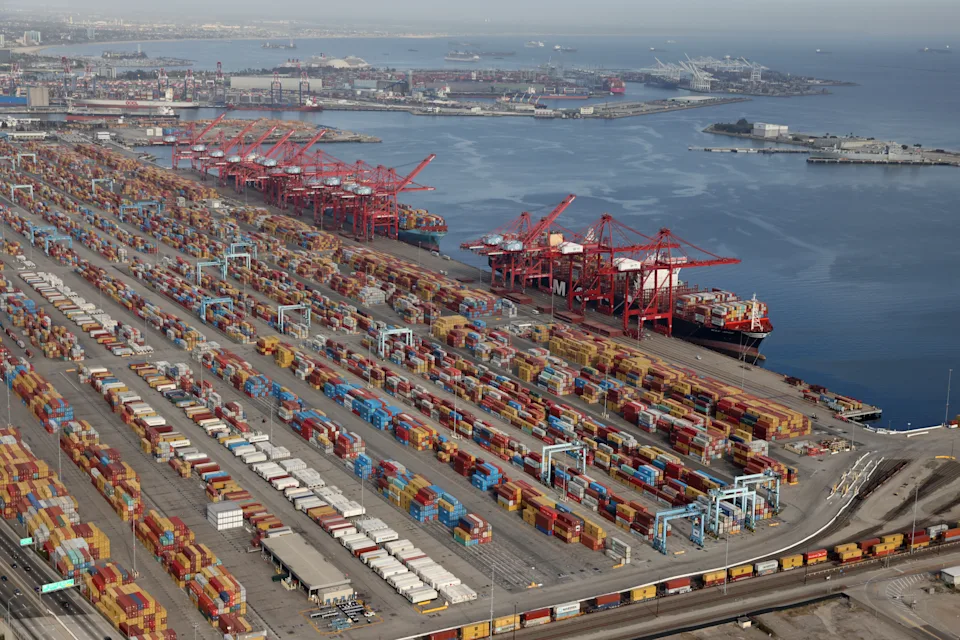This Crazy Shipping Crisis, Explained
This Crazy Shipping Crisis, Explained
Andy Serwer with Max Zahn Sat, October 9, 2021
As we head closer to the second anniversary (if that’s the right word for it) of the pandemic, it’s clear we’ve made some great progress fighting COVID-19.
We have testing and vaccines that work. We know masks and social distancing are effective. Despite the nagging disruptions that mark much of what we do — and even worse the horror of continued sickness and death — in some ways, we can hope that the worst is behind us.
But not all of it. An under-recognized characteristic of any pandemic is its nonlinear course, which delivers, in true viral fashion, shocking, unanticipated consequences. That brings us — 20 or so months into the COVID-19 pandemic — to a vast oceanic parking lot dotted with scores of giant container ships off the ports of Long Beach and Los Angeles.
No doubt you’ve heard how the world’s supply chain is being stressed like never before, resulting in shortages and delays in everything from semiconductors, to cars, sneakers, exercise equipment, and Rolexes. Initially this was because factories in Asia (for example) had to close for weeks or even months because workers were sick with the coronavirus. That was true and still is the case in Vietnam, for instance.
Now the pain point has shifted to ships. What we are witnessing is a massive, unprecedented traffic jam of humankind's largest sea vessels that is at the very core of the conundrum.
“I don't think anyone's ever seen anything like this in their careers, anyone who's alive,” says a board member of a large shipping company whose family has been in the business for decades. "Containergeddon,” is what Steve Ferreira of shipping consultancy Ocean Audit calls it, according to Reuters.
How bad is this? How did it happen?
What does this mean going forward?
How will this impact the U.S. economy?
And how and when does it get resolved?
Let’s start at the very beginning, (as Maria von Trapp might say). First understand that 90% of the world's global trade is shipped by sea, with 70% in containers. Over the past two decades, a number of trends have shaped the business.
First, when it comes to the United States, we have been increasing our outsourcing and reliance on imported goods. Example: In January 1985 (as far back as data went), we imported $293 million of goods from China (and had a positive trade balance). Flash forward to today, in August of this year, our imports from China totaled nearly $43 billion. That’s up 146-fold in 36 years. Our imports from Asia across the board are up. China is the No. 1 exporting nation to the U.S., but Japan, South Korea, and Vietnam are also on the top 10 list.
Second, companies and consumers increasingly count on just-in-time inventory systems to order goods. That makes for lower inventories, which reduces costs for U.S. companies and allows consumers unprecedented immediate gratification from a global cornucopia of goods. Example: If Pottery Barn needs 50 couches from China, the company orders it, and two weeks later or three weeks later, the couches are on the West Coast of the United States.
Third, the shipping business over the past decade has not been very profitable — ”a fricking nightmare” my source called it — until now (see below), which meant there was little investment in new ships. Meanwhile in the U.S., railroads have been cutting costs and reducing headcount. This on that last point from an AP story:
“More than 22% of the jobs at railroads Union Pacific, CSX and Norfolk Southern have been eliminated since 2017, when CSX implemented a cost-cutting system called Precision Scheduled Railroading that most other U.S. railroads later copied. BNSF, [owned by Berkshire Hathaway] the largest U.S. railroad and the only one that hasn’t expressly adopted that model, has still made staff cuts to improve efficiency and remain competitive.”
Shipping containers are unloaded from ships at a container terminal at the Port of Long Beach-Port of Los Angeles complex, amid the coronavirus disease (COVID-19) pandemic, in Los Angeles, California, U.S., April 7, 2021. REUTERS/Lucy Nicholson
What all this means is that the global supply chain, particularly the part of it that connects Asia to the U.S., has been running at full capacity with no margin for error.
“When you have a problem anywhere in the supply chain, it’s going to have a ripple down effect, like playing dominoes,” says Cathy Roberson, founder and president of supply chain consulting group Logistics Trends and Insights LLC, and former market analyst at UPS Supply Chain Solutions. “If freight is late arriving at port, that means the time scheduled for the truck to be at port is wrong; now you have to go back and reschedule.
That will cause additional delays and costs; now you have to put the items in a temporary warehouse if you can find space. Incurring additional costs for that. From there, once you finally get a truck, moving it inland you have to constantly reschedule delivery times. Having to jungle all that, monitor that, takes time and takes people and costs extra money.”
A very long article but informative:
To continue reading, please go to the original article here:

